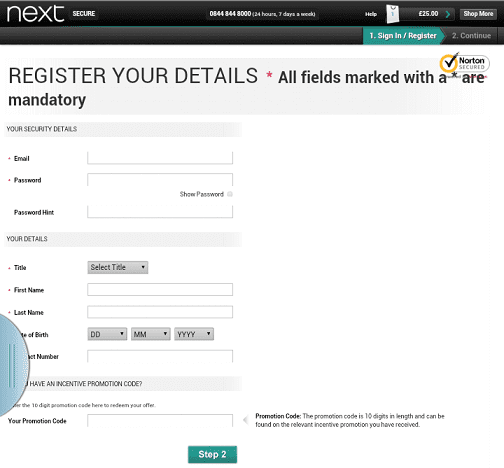How e-retailers can avoid Buyer's Remorse by considering where coupon codes are introduced in the checkout process
In previous posts I have mentioned something that in the offline retail world that is known as buyer’s remorse. But having recently seen so many instances of this simple concept being evident on so many retailers sites I felt that it warranted a post all of its own.
Buyer’s Remorse, in the retail trade is what happens when customers have a sudden regret or recognition of a perceived barrier which introduces doubt into their mind forcing reassessment of their purchase before the purchase has even been made.
Think about it. How many times have you been stood in a queue waiting to get to a till point to make a purchase. This added time at the checkout allows you the extra head space to re-consider what you have placed in your basket or trolley and suddenly that voice in the back or your head starts saying ‘do you really need to buy that? Could I find that cheaper somewhere else?’. Before you know it, you start bailing out those unnecessary items or decide to look for a discount elsewhere.
So how do you prevent this from happening when customers show with you? Tesco’s up and down the country open more tills. Sure this is great customer service to allow you to get on your way faster – it also has the added benefit that you don’t stop long enough to start re-considering your purchases. They make it so easy that you don’t even think about looking for it cheaper elsewhere - it’s so convenient where you are!
The next question then, must be, so how do you rescue these online sales?
One of the most frequent things that I see happening at checkout is a great big ‘Promo Code’ box that can serve to distract your customers. If a customer has added to basket and then proceeded through to view the basket they have almost committed to buying, certainly shown intent. Most frequently checkout paths will have a ‘confirm’ or further ‘checkout’ button which takes the user through to the next stage – at which point the ‘Promo Box’ can often be seen. So what’s the problem?! The problem is that if a customer has committed to buy… they are almost at the point of taking their credit card out… and you say ‘oh actually there might be a promo code, if you can find it, that will give you a discount on this’ – guess what happens?! Yep- they disappear off to Google to search for a promo code! At which point, for those that are swayed by buyer’s remorse, the retailer may have:
A. Lost the sale altogether if the person doesn’t find a promo code
or
B. Lost profit on the sale because what was going to be a full price sale, will now be discounted.
With some retailers this happens even earlier on, even as early on as the view basket page itself!
However there is some hope. Some retailers are a step ahead of the rest and make sure that nothing gets in the way of their customers and their checkout. Take ASOS for example who have dealt with the ‘could I get this cheaper?’ question by ensuring it doesn’t even cross your mind! And the result (in part)? ASOS were one of the only top retailers NOT to see a slide in fashion sales at the start of 2013 according to IMRG/Experian Hitwise.
With the IMRG/ Experian Hitwise findings in mind, I investigated the other retailers who appeared in their Hot Shops List to see just how many of them also removed the ‘promo code’ barrier from their checkout paths.
Next.co.uk
The Next website has the promo code loud and clear at Step 2 of their checkout path as the following mobile screenshot shows.

Without access to Next’s stats I can’t tell how many people bail at this point to go in seek of a promo code. However a quick look at the Google Keyword Tool tells us that around 4,400 local searches are conducted monthly for the search ‘next promo code’. Assuming an average basket value of £100 (IBM stats Average transaction value Dec 2012) that could amount to £440, 000 in lost or at least deferred sales per month!
The table below looks at the rest of these Top Fashion Retailers and what they could potentially be losing as a result of advising their customers just before they buy that there might be a discount code and inviting them to go and look for one!
| Website |
Downstream Search Term |
No. of Local Monthly Searches |
Approx Ave Basket Value |
Potential Lost Monthly Sales Value |
Checkout Step where Promo Box Appears |
| www.next.co.uk |
Next promo code |
4,400 |
£100 |
£440,000 |
Step 2 of Checkout |
| www.newlook.com |
New look promo code |
18,100 |
£100 |
£1,810,000 |
View Basket Page (prominent) |
| www.topshop.com |
Topshop promo code |
14,800 |
£100 |
£1,480,000 |
View Basket Page |
| www.riverisland.com |
River Island promo code |
18,100 |
£100 |
£1,810,000 |
View Basket Page (prominent) |
| www.hm.com |
H and m promo code |
18,100 |
£100 |
£1,810,000 (may be less because of location of box) |
Step 3/4 -After full registration |
When looked at in this simple idea of loss, the impact that placing a discount code 'distraction' on the checkout path can have is alarming.
Even more so when the only retailer whose sales bucked trends was the only one without a promo code sales distraction smack bang in the middle of their checkout path. It certainly should raise your interest in taking steps to avoid conversion path 'traps'.








